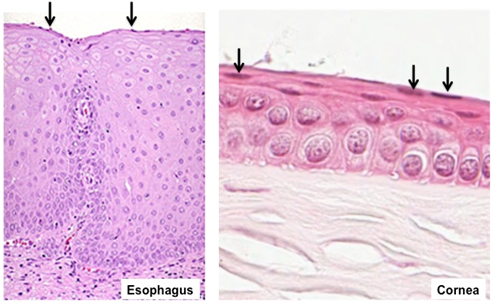| Stratified squamous (nonkeratinized)
This type of epithelium is classified as
such because it is multiple cell layers in thickness, the cells of
its most superficial layer are squamous in shape, and it lacks
keratinization at its free surface.
- Take a look at the flattened
cells and their nuclei (arrows) in the superficial layers of
these examples of esophageal and corneal epithelia. Note the
striking differences in cell shape and nuclear morphology in the
surface layers compared to the deeper layers of these epithelia.
- This type of epithelium
functions to provide protection and serve as a lining or
covering for moist internal cavities of the body (e.g. vagina,
oral cavity, and esophagus).
- Scan the epithelium lining the
larynx,
cornea,
 esophagus,
esophagus, and vagina,
to see several examples of stratified squamous, non-keratinized
epithelium. Notice how the flattened cells in the most
superficial layer still have their nuclei.
and vagina,
to see several examples of stratified squamous, non-keratinized
epithelium. Notice how the flattened cells in the most
superficial layer still have their nuclei.

Now for some clinical relevance
- When subjected to prolonged
irritation, an epithelium may transform or undergo metaplasia to
a different type of epithelium. This is a defense mechanism in
which the metaplastic epithelium is sturdier and better able to
withstand the chronic irritation.
- Examples of metaplasia include
the transformation of tracheal ciliated pseudostratified
columnar epithelium to stratified squamous in heavy smokers and
esophageal stratified squamous epithelium to simple columnar
(mucus-secreting) epithelium in individuals with chronic
gastro-esophageal reflux disorder.
Stratified
keratinized squamous epithelium. |